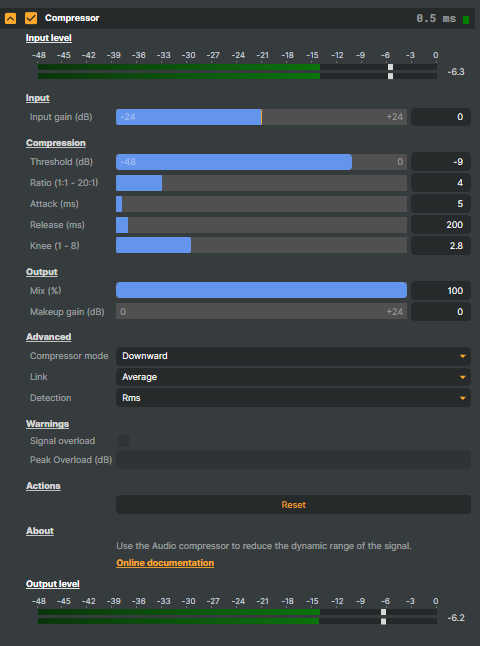The audio Compressor operator control the dynamic range of a sound signal. In simple terms, it makes loud sounds quieter and quiet sounds louder, helping to even out the overall volume.
A compressor is mainly used to reduce the dynamic range of a signal. Especially modern music is mostly compressed at a high ratio to improve the overall loudness. It’s done to get the highest attention of a listener, "fatten" the sound and bring more "power" to the track. If a signal is compressed too much it may sound dull or "dead" afterwards or it may start to "pump" (which could be a powerful effect but can also destroy a track completely). The right compression is the key to reach a professional sound and is the high art of mixing and mastering. Because of its complex settings it may take a long time to get the right feeling for this kind of effect.
Compression is done by detecting the volume above a chosen level threshold and dividing it by the factor set with ratio. So if you set the threshold to -12dB and your signal reaches -6dB a ratio of 2:1 will result in a signal at -9dB. Because an exact manipulation of the signal would cause distortion of the waveform the reduction can be levelled over the time. This is done by setting "Attack" and "Release" determines how long the signal has to rise above the threshold before any reduction will occur and release sets the time the signal has to fall below the threshold to reduce the reduction again. Shorter signals than the chosen attack time will be left untouched. The overall reduction of the signal can be made up afterwards with the makeup setting. So compressing the peaks of a signal about 6dB and raising the makeup to this level results in a signal twice as loud than the source. To gain a softer entry in the compression the knee flattens the hard edge at the threshold in the range of the chosen decibels.

This operator displays the audio input level before processing and the output level after the operator has been applied, allowing you to monitor how the adjustments affect the signal.
A miniature audio meter (VU meter) in the header indicates incoming audio, so you can quickly verify that the operator is receiving audio even when it is collapsed.
Input
- Input gain (dB) - pre-gain, -24 to +24 dB.
Compression
- Threshold (dB) - If the audio level rises above this level it will affect the gain reduction.
- Ratio (1:1 - 20:1) - Set a ratio by which the signal is reduced. 1:2 means that if the level rose 4dB above the threshold, it will be only 2dB above after the reduction. Default is 2. Range is between 1 and 20.
- Attack (ms) - Amount of milliseconds the signal has to rise above the threshold before gain reduction starts.
- Release (ms) - Amount of milliseconds the signal has to fall below the threshold before reduction is decreased again.
- Knee (1-8) - Curve the sharp knee around the threshold to enter gain reduction more softly.
Output
- Mix (%) - Percentage mix between the compressed signal, and the uncompressed signal. Default is 100%.
- Makeup gain (dB) - Post-gain, -24 to +24 dB.
Advanced
- Compressor mode - Set mode of compressor operation. Can be upward or downward. Default is downward.
- Link - Choose if the average level between all channels of input stream or the louder(maximum) channel of input stream affects the reduction. Default is average.
- Detection - Should the exact signal be taken in case of peak or an RMS one in case of rms. Default is rms which is mostly smoother.
Warnings
- Signal overload - if the peak level is above 0dBFS, the signal overload indicator will be active for two seconds.
- Peak Overload (dB) - last measured peak value in dBFS.
Use Settings to adjust how long the signal overload indicator stays active, and Project Options to change the maximum peak level displayed in all audio meters to your preference.
For more information on audio, see Working with audio in scenes.
(The operator is available in R1 2025 and later releases)